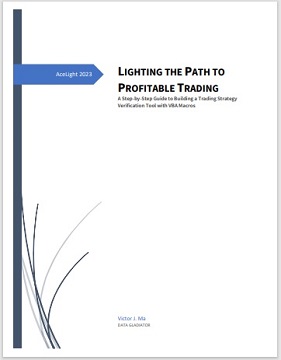Mastering the Art of Intraday Trading:
Strategies to Make (and Keep) Your Cool in the Wild World of Day Trading
|
|
Welcome to the exciting world of intraday trading, where you can experience
the thrill of making and losing money within the span of a single day! It's
like being on a rollercoaster ride, but instead of screaming your lungs out,
you're screaming at your computer screen. Who needs adrenaline-pumping
adventure parks when you can have the stock market, right? Just make sure
you buckle up your seatbelts, because the ups and downs can get pretty wild.
Intraday trading, also known as day trading, is a type of trading
where the trader buys and sells financial instruments, such as stocks,
currencies, commodities, or derivatives, within the same trading day.
Intraday trading involves opening and closing a position in a financial
instrument on the same day, and the trader does not hold the position
overnight. The goal of intraday trading is to make a profit from the price
movements of the financial instrument in a short period of time, usually
within a few minutes, hours, or a single trading session. Intraday trading
requires quick decision-making, knowledge, experience, and discipline, and
it involves a high level of risk due to the volatile nature of financial
markets. Traders use various technical and fundamental analysis tools, such
as charts, indicators, news, and market trends, to identify profitable
trading opportunities and make informed trading decisions.
Intraday
trading is popular among traders who seek short-term profits and do not want
to hold positions overnight due to market risks or trading costs. In this
blog post, we will discuss some of the best intraday stock trading
strategies that probably can help traders make some profitable trades.
1. Momentum
Trading Strategy
The momentum trading strategy is based on the principle
that stocks that are trending in a particular direction are likely to
continue in that direction. Traders can identify stocks that are trending by
analyzing the stock's price and volume. Once a trader has identified a stock
that is trending, they can buy or sell the stock depending on the direction
of the trend.
2. Breakout Trading Strategy
The breakout trading
strategy is based on the principle that when a stock breaks out of a trading
range, it will continue to move in the direction of the breakout. Traders
can identify a breakout by looking for a significant increase in the stock's
volume and price movement. Once a trader has identified a breakout, they can
buy or sell the stock depending on the direction of the breakout.
3.
Gap and Go Trading Strategy
The gap and go trading strategy is based on
the principle that when a stock opens with a significant gap up or down, it
will continue to move in the direction of the gap. Traders can identify a
gap up or gap down by comparing the previous day's closing price with the
current day's opening price. Once a trader has identified a gap up or gap
down, they can buy or sell the stock depending on the direction of the gap.
4. Mean Reversion Trading Strategy
The mean reversion trading
strategy is based on the principle that stocks that have moved significantly
away from their mean price are likely to revert to the mean. Traders can
identify stocks that have moved significantly away from their mean price by
analyzing the stock's price and volume. Once a trader has identified a stock
that has moved significantly away from its mean price, they can buy or sell
the stock with the expectation that the stock will revert to the mean.
5. Scalping Trading Strategy
The scalping trading strategy is based
on the principle of taking advantage of small price movements in a stock.
Traders can identify small price movements by analyzing the stock's price
and volume. Once a trader has identified a small price movement, they can
buy or sell the stock with the expectation of making a small profit.
Intraday trading can be profitable for experienced and disciplined traders
who have a sound trading strategy, risk management skills, and market
knowledge. However, intraday trading involves a high level of risk and
volatility, and it is not suitable for all investors. The profitability of
intraday trading depends on various factors, such as market conditions,
trading costs, trading skills, and emotional control.
Some advantages
of intraday trading that may increase its profitability are:
1. High
liquidity: Intraday trading involves trading in highly liquid markets, such
as the stock market or forex market, where traders can easily buy and sell
financial instruments at the prevailing market price. High liquidity ensures
that traders can enter or exit trades quickly and at a fair price.
2.
Quick profits: Intraday trading allows traders to make quick profits from
price movements during the day. Traders can buy low and sell high or sell
high and buy low, depending on the market conditions.
3. Flexibility:
Intraday trading allows traders to trade in different financial instruments,
such as stocks, currencies, commodities, or derivatives, and use various
trading strategies, such as scalping, momentum trading, or breakout trading.
4. Low capital requirements: Intraday trading does not require a large
amount of capital to start, and traders can use leverage to increase their
buying power. However, traders should be cautious about using leverage as it
can increase their risk exposure.
Despite these advantages, intraday
trading can also be risky and unprofitable if the trader does not have the
necessary skills and knowledge. Traders should be aware of the risks
involved and should only trade with money they can afford to lose. Intraday
trading also involves trading costs, such as commissions, fees, and
slippage, which can reduce the trader's profits.
Here is how intraday
stock trading works in practice:
1. Market Analysis: The trader
analyses the stock market using technical and fundamental analysis tools to
identify stocks that are likely to move in price during the day. Technical
analysis involves studying charts, patterns, and indicators to identify
buying and selling opportunities. Fundamental analysis involves analyzing
company financials, news, and economic data to assess the stock's value and
potential.
2. Order Placement: Once the trader has identified the stocks
to trade, they place orders with their broker to buy or sell the stocks at
the prevailing market price. Traders may use different types of orders, such
as market orders, limit orders, stop-loss orders, or trailing stop orders,
depending on their trading strategy and risk tolerance.
3. Trade
Execution: The broker executes the trader's orders, and the trader buys or
sells the stocks at the market price. The trader may monitor the stock's
price movements during the day to make further buying or selling decisions.
4. Profit and Loss Calculation: If the stock's price moves in the trader's
favor, they may close the position by selling the stock for a profit. If the
stock's price moves against the trader's position, they may close the
position by selling the stock for a loss. The trader calculates their profit
or loss based on the difference between the buying and selling prices and
the number of shares traded.
There are some important intraday
trading rules that traders should follow to increase their chances of
success and manage their risks. Here are some of the key rules:
1.
Trade with a plan: Before starting intraday trading, traders should have a
trading plan that outlines their trading strategy, risk management rules,
and profit targets. The plan should be based on the trader's experience,
knowledge, and goals.
2. Set a stop-loss: Traders should always set a
stop-loss order to limit their losses in case the stock price moves against
their position. The stop-loss order should be based on the trader's risk
tolerance and trading strategy.
3. Use proper leverage: Traders should
use proper leverage to manage their capital effectively and avoid excessive
risk. Using too much leverage can lead to significant losses and margin
calls.
4. Follow market trends: Traders should follow the market trends
and avoid trading against the trend. Trading with the trend increases the
chances of making profitable trades.
5. Manage emotions: Intraday trading
can be stressful, and traders should manage their emotions, such as fear and
greed, to make rational trading decisions. Traders should avoid overtrading,
revenge trading, or chasing losses.
6. Monitor trading costs: Traders
should monitor their trading costs, such as commissions, fees, and slippage,
and factor them into their trading plan. High trading costs can reduce the
trader's profits.
7. Practice risk management: Traders should practice
risk management techniques, such as diversification, position sizing, and
portfolio management, to reduce their overall risk and protect their
capital.
By following these intraday trading rules, traders can
increase their chances of success, minimize their losses, and become more
disciplined and consistent in their trading.
Because intraday trading
is a highly risky trading strategy, conducting proper testing is crucial for
every intraday trader. Backtesting is essential for intraday trading as it
allows traders to evaluate the effectiveness of their trading strategies
using historical market data. Backtesting involves applying a trading
strategy to past market data to simulate how the strategy would have
performed in real-time. By analyzing the results of backtesting, traders can
identify the strengths and weaknesses of their strategies and make necessary
adjustments to improve their performance.
 Here
are some reasons why backtesting is important for intraday trading: Here
are some reasons why backtesting is important for intraday trading:
1. Evaluating strategy performance: Backtesting helps traders evaluate how
their intraday trading strategy would have performed in the past, which
gives them an idea of how it may perform in the future. This analysis helps
traders determine if their strategy is effective or needs to be adjusted to
improve performance.
2. Risk management: Backtesting allows traders to
test different risk management techniques, such as stop-loss orders or
position sizing, to determine which ones are effective in minimizing losses
and maximizing profits.
3. Minimizing emotional bias: By backtesting
their intraday trading strategies, traders can minimize emotional bias and
avoid making impulsive decisions based on emotions. Backtesting provides a
more objective evaluation of the strategy's performance, which helps traders
make more informed trading decisions.
4. Enhancing discipline:
Backtesting encourages traders to be more disciplined in their trading
approach. It helps traders follow their trading plan and avoid deviating
from it, which can help them achieve better results.
For more
information about the backtesting, Click
LIGHTING THE PATH TO PROFITABLE TRADING: A Step-by-Step Guide to Building a Trading Strategy Verification Tool with VBA Macros to get the whole tutorial handbook for free!
And click Free Trial to download strategies testing tools, all for a 30-day Free Trial.
Click on Subscription to order more strategies testing tools to help your stock trading.
So, there you have it - some intraday trading strategies that might
just make your day trading a little less terrifying. But let's be real, no
amount of strategies can completely eliminate the stress and anxiety of
intraday trading. At the end of the day, it's just you and your computer
screen, trying to outsmart the market. But hey, just remember this sage
advice from the famous investor Warren Buffett: “Be fearful when others are
greedy, and greedy when others are fearful.” Happy trading!
|


|

Free Tutorial
Share
|
|
|
|